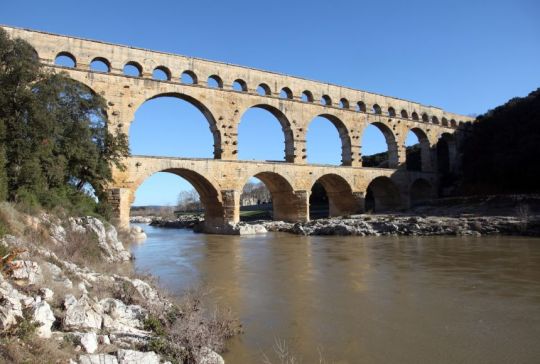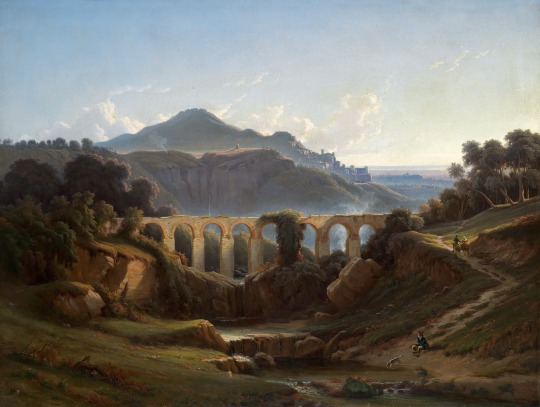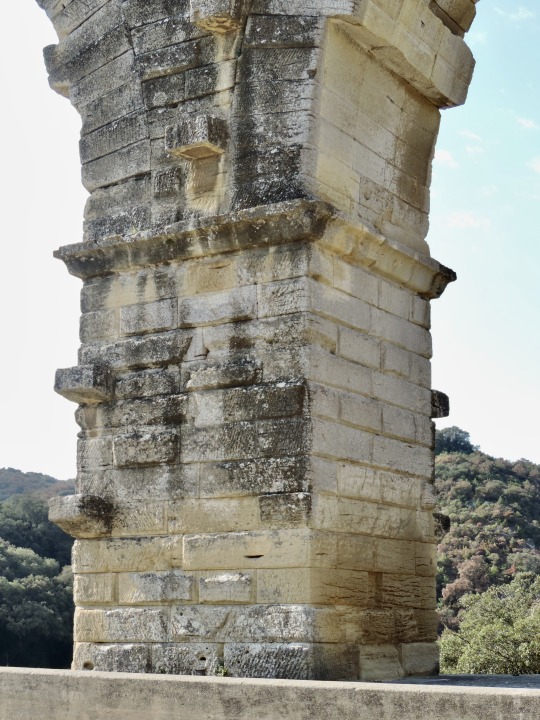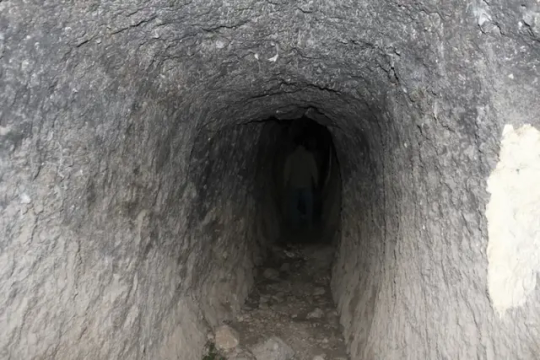#Roman aqueduct
Explore tagged Tumblr posts
Text

Aqueduct of Segovia, Segovia, Spain: The Aqueduct of Segovia is a Roman aqueduct in Segovia, Spain. It was built around the first century AD to channel water from springs in the mountains 17 kilometres away to the city's fountains, public baths and private houses, and was in use until 1973. Wikipedia
347 notes
·
View notes
Text

@sherrylephotography 5/23
Segovia, Spain, would be second best of the cities that I visited on our vacation for me. Because of how impressive and well preserved this Roman aqueduct is in the old town of Segovia, it is a must see sight. This enormous aqueduct was built around c. 50 BC.

#original photography on tumblr#roman aqueduct#sekovia#spain#my photography#sherrylephotography#landscape photography#vacation spain#gimp
148 notes
·
View notes
Photo





Ancient Roman Pipelines Discovered in Crete
Ongoing construction work on a new highway on the island of Crete revealed parts of an ancient water transport pipeline built during the period of Roman rule on the island.
The archaeological discovery reportedly consists of a water transport pipe that was part of the Roman aqueduct of Hersonissos.
Aqueducts were an essential element of Roman infrastructure across the empire, including in ancient Greece. They ensured the availability of fresh water in densely populated urban areas where demand was high.
Roman aqueduct discovered in Crete
Manolis Makrakis, the head of the Directorate of Primary Education of Lasithi, spoke at length about the discovery of parts of the Roman aqueduct on Crete.
“The section of the pipeline is located 5 km south of the national hub of Hersonissos and came to light, as part of the works for the opening of the road that will connect BOAK with the airport of Kastelli,” said Makrakis.
“The pipeline carried water from Kalo Chorio and Krasi to the Peninsula. It consists of two parts, an open (groove) width of approx. 40cm and a clay (closed) one with a diameter of approx. 25cm. We are waiting for more information from the archaeological service,” he added.
Historical context
Makrakis, who authored the book Story of Crete, spoke at length about the history of Roman aqueducts and water transport pipelines on the island during antiquity.
Quoting an extract from the book, Makrakis explained “The aqueduct of Hersonissos was a great work of the Roman era. The Romans were leaders in similar projects. Because the morphology of the land consists of ups and downs, they made the necessary works with the water bridges so that the water flows smoothly in the groove above the bridges. In many places, this groove was supported by wall constructions.”
“Its length was 14km, it took the water from two sources located at a great distance from each other,” the author continued. “The first source was located at the “Leontari” location in Krasi, while the second one was 3 meters south of the tap of the community reservoir of Kalos Horiou Pediados.”
“Then the two pipelines joined into one that ended in the Peninsula. The transport capacity of the pipeline was twice that of Lyktos. The pipeline passed through gullies, ravines and steep (inclined) slopes), through the uneven surfaces of the mountains and ended at the Peninsula.”
“The water of the pipeline was collected in a very large tank located on a hill south of the Port of Hersonissos at the “Palatia” location. This covered vaulted tank was 58m long, 22m wide, and 5.5m deep. The 4.5m underground section was carved out of natural rock. The thickness of the western walls was 1.60m.”
The Romans ruled Crete from 67 BC and they developed infrastructure such as aqueducts in and around the island’s pre-existing ancient Greek cities.
By Alexander Gale.
#Ancient Roman Pipelines Discovered in Crete#roman aqueduct#archeology#archeolgst#ancient artifacts#history#history news#ancient history#ancient culture#ancient civilizations#roman history#roman empire
32 notes
·
View notes
Text

Pont du Gard, Région Occitanie, France
0 notes
Text

EL ACUEDUCTO DE SEGOVIA
#acueducto#aqueduct#segovia#castilla y león#castile and león#roman#romano#españa#spain#europe#europa
823 notes
·
View notes
Text
What to Do When You are Under Attack
Isaiah 36-37 The nation is under attack. A powerful enemy has announced his intention to destroy Israel and mocked all attempts to defend the nation or even look for help. The nation’s doom is sure, inevitable, so they would have Israel believe. You can read it all in Isaiah 36. Now the question is what to do. What do you do when you are under attack? King Hezekiah gives us a model in chapter…

View On WordPress
0 notes
Text

Aqua Claudia
* Aqueduct park, Rome
* Photo by James Anderson
Attribution: Rijksmuseum, CC0, via Wikimedia Commons
#Aqua Claudia#Parco degli acquedotti#Rome#ancient#Roman#ruins#aqueduct#old photo#James Anderson#animals
202 notes
·
View notes
Text

Aqueduc Saint-Clément, Montpellier by sir20
#original photographers#photographers on tumblr#photography#cityscape#architecture#sir20#photographie#fotografía#fotografia#fotografie#original photography#artists on tumblr#creators on tumblr#fine art photography#urban landscape#urban#historical#history#roman#aqueduct#winter#reflection#montpellier#occitanie#france#europe#architectural#architecture photography#ancient architecture#cityscapes
247 notes
·
View notes
Text

View of the Campagna with Roman Aqueduct
by Edmund Hottenroth
#edmund hottenroth#art#landscape#roman#campagna#aqueduct#italy#rome#europe#european#ruins#ruin#nature#picturesque#romanticism#romantic
189 notes
·
View notes
Text










Forest (No. 96)
Pont du Gard, F
#Pont du Gard#France#trail#travel#original photography#vacation#tourist attraction#landmark#architecture#archaeology#history#Southern Europe#summer 2021#landscape#countryside#woods#forest#nature#flora#Gardon River#engineering#Roman history#French history#aqueduct
31 notes
·
View notes
Photo

Source details and larger version.
Only connect -- my modest collection of vintage bridge imagery spans the centuries.
16 notes
·
View notes
Text


Fondations: tronc d'olivier centenaire et base de l'aqueduc, Pont du Gard, Occitanie, 2016.
The ancient tree and the ancient aqueduct, much older yet, are about 100 m apart.
#archaeology#aqueduct#roman empire#agriculture#olive tree#pont du gard#occitanie#france#2016#photographers on tumblr
28 notes
·
View notes
Text

Aqueducto de Segovia, ESPAÑA
#aqueducto#romano#roman#aqueduct#segovia#castilla y león#castile and leon#españa#spain#europe#europa
114 notes
·
View notes
Text

A 1700-Year-Old Roman Water Tunnel Discovered in Turkey
It was revealed that in the Besni district of Adıyaman province, located in the Southeastern Anatolia Region of Turkey, the Romans dug a 150-meter-long water tunnel into the mountain 1,700 years ago to irrigate their lands with the water flowing from the river.
An interesting 1,700-year-old structure dating back to the Roman Period was identified in the mountainous area in the Kantara region within the borders of Geçitli (Kantara) village of Adıyaman’s Besni district.
The water tunnel, which was previously known to the villagers but was detected for the first time by the authorities, was entered.
It has been determined that the tunnel, which is 150 meters long and 80 centimeters wide, and 1.5-2 meters high, was carved out by the Romans to transport water from the Sofraz River to the fields. The water canal constructed along the riverbank joins with the excavated water tunnel and extends to the agricultural lands to the south.
In order to construct a significant number of water supply tunnels known as cuniculi in the northeast of Rome, the Etruscans adopted the qanat technique in the sixth century BCE. They later imparted their knowledge to the Romans, who built aqueducts using the qanat technique.



Romans used a method known as “fire-quenching” to break hard rocks, which involved heating the rock with fire and then quickly cooling it with cold water. Hard rock could make progress extremely slow, and it was not unusual for tunnel construction to take years or even decades.
Adıyaman Museum Director Mehmet Alkan entered the water tunnel with Geçitli Village Headman Abdullah Güllü.
It was stated that the tunnel is an important historical structure with its interesting structure. During the investigations carried out in the same region, living spaces and rock tombs dating back to the Roman period were found.
Adıyaman Museum Director Mehmet Alkan emphasized the magnificent nature of the tunnel and stated, ” We discovered that this tunnel, which dates back to the 3rd century AD, or 1,700 years ago, was built to transport water from the Sofraz River to fields on the opposite side of the living area. We have witnessed how remarkable this water tunnel, built 1,700 years ago, appears. This tunnel, showcasing exceptional craftsmanship and serving as a remarkable piece of art, is the longest water tunnel found in Adıyaman” he said.
Geçitli Village Headman Abdullah Güllü said, “We knew there was a tunnel here before, but we were afraid to go into it. Our manager came, and we entered together. We made inspections. It is a very magnificent and beautiful tunnel.”
By Oğuz Büyükyıldırım.

#A 1700-Year-Old Roman Water Tunnel Discovered in Turkey#Anatolia#aqueduct#ancient artifacts#archeology#archeolgst#history#history news#ancient history#ancient culture#ancient civilizations#roman history#roman empire
40 notes
·
View notes
Text

Pont du Gard, Région Occitanie, France
#aquaeductus#aqueduct#Roman Empire#Rome#classical antiquity#antiquity#architecture#art#art history#archeology#history#Europe#France#Occitanie
18 notes
·
View notes
